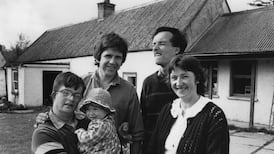Before the high-rises are levelled, students will be recreating - and celebrating - Ballymun at the Briery Gap, they tell Louise Holden.
"This modern concrete Stonehenge, named for 1916 heroes on the number 13 bus route, lines of washing hanging like bunting for a party that never happens - is this somebody's idea of a joke?"
- From Thicker Than Water
Dublin's Ballymun flats have become a byword for bad times, bleak futures and blighted lives. Now that the towers' days are numbered, the students of Ballymun Senior Comprehensive, most of whom are former residents, have written an elegy to the place they have always called home. Thicker Than Water is a dramatic reflection on the past struggles of the Ballymun community as it faces a new era. In 30 minutes the students create a world of abuse, alcoholism, despair, violence, crime and boredom. They touch on Garda community relations, under-age sex, suicide, truancy, joyriding and homelessness.
This is not, however, a dark work.
"Anyone coming to Ballymun for the first time sees a bleak, unhappy place," says Stephanie Kelly, a Transition Year student. "We were born here. We have an affection for the place. It's great that this area is finally getting some attention, and that the flats are coming down, but we want to remember some of the good as well as the bad."
People in this community are strongly united, having lived at such close quarters for so long.
"We understand each other's problems," says student Nicola Moore. "You can hear your neighbours fighting, so you've a fairly good idea what's going on."
When this group decided to enter a play for the Briery Gap Theatre Festival they knew that in order to make it work, it would have to be relevant to them. They borrowed digital cameras and went to the abandoned flats to capture images of the doomed space. Using these images, and their own life experience, they scripted a play that they felt reflected life in the Ballymun flats. The result is a clash of love and hatred, hope and despair, family unity and domestic warfare.
The central character, Darren, is ready to run away. He's had enough of his abusive father, drunken mother, troublesome brothers, unsympathetic teachers and suspicious gardaí. He steals his father's bank card, but has to wait until the next day to use it. He spends the night in an abandoned flat in one of the high-rises. It's the same flat where his drug-addicted sister killed herself some years before. His dark night of the soul begins.
Like many residents of the Ballymun flats, Darren can't wait to get out. What he learns that night, in a series of confrontations, flashbacks and imaginings, is that he cannot run from his problems and that he must face them. He also starts to understand that if he leaves he will lose his girlfriend, his loyal friend Tony, his loving (if troubled) mother, and his father, who is broken by the death of his daughter and badly in need of his son's help. He decides to give Ballymun another chance.
The play has an air of authenticity because the actors have all been touched by its themes. Seven hundred local people have already been to see the play and the response has been overwhelming, says drama teacher Louise Lowe.
"We've received loads of letters from students, community workers and residents thanking us for staging something so relevant to them. It's the first time anyone here has seen Ballymun life played out in artistic form. The themes are universal, but the setting is unmistakably Ballymun."
The cast has been asked to stage performances in Mountjoy Prison, Dún Laoghaire, Tallaght and Finglas. Next Saturday they will perform alongside eight other Transition Year finalists in the Briery Gap Theatre Festival.
When the idea of entering the competition was first mooted last November, staff at the school were not enthusiastic.
"We have no history of drama in Ballymun Comprehensive," says director and fifth-year student Kelly Hickey. "The authorities here felt that drama was not relevant to these students. I've been involved in dramatic production for years and I know that everyone can use theatre to express their own truths. The students believe in the subject-matter of this play and that is why it is working."
Hickey, who is studying for a FETAC National Diploma in Performing Arts, helped the other students to write the script and find their characters using concepts from dramatic theorists such as Aristotle, Stanislavsky and Brecht.
"Studying techniques such as Aristotle's script structuring, Brecht's alienation theory and Stanislavsky's 'neurosis-provoking moments' helped us to create something that was not only real to our audiences but that worked theatrically," explains Liam Roe, who plays Darren.
The action is played out in a faithfully reconstructed abandoned flat. Everything from the graffiti on the walls to the rubbish on the floor is copied from the Ballymun complex. An old sheet hanging in the window is a projector screen for images from the flats, recorded by the students for posterity.
The result is a weightless production that doesn't labour its themes and balances drama with humour. The acting is natural and vibrant; the set simple and affecting.
"We're glad to have the chance to speak about our place in this way at this time," says assistant director Carrie Graham. "It's the end of an era for Ballymun and we're glad about that, but there are some things about those days worth celebrating."











